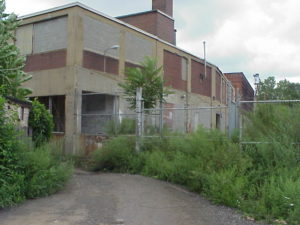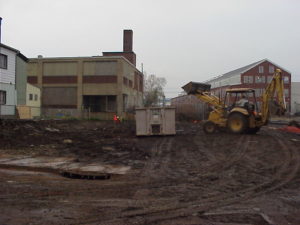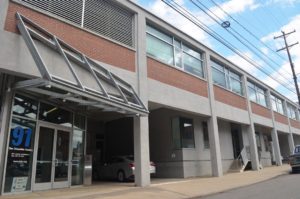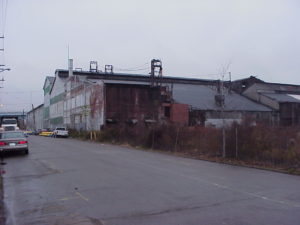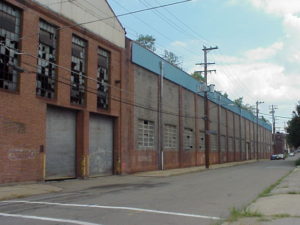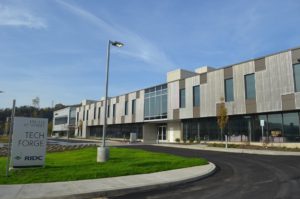A Guest Article for REVITALIZATION by Donald F. Smith, Jr., Ph.D.
Pittsburgh, Pennsylvania is rapidly gaining a reputation as a center for the robotics industry, creating products and technologies that will change our future economy and our lives with innovations ranging from driverless cars and unmanned drones to exciting advancements in the field of medicine.
It’s fascinating to consider that “Robotics Row”—as an area in Pittsburgh’s Lawrenceville and Strip District neighborhoods is now being called—started with the redevelopment and transformation of a former steel mill into a technology center that became a community anchor.
The Lawrenceville Technology Center was formerly an industrial site owned by the Heppenstall Steel Company and later partly occupied by a chocolate manufacturer.
The property was, at the time, part of an urban community that Pittsburgh Magazine said was: “Once a blue-collar neighborhood more down-and-out than up-and-coming.”
In 2002, the Regional Industrial Development Corporation of Southwestern Pennsylvania (RIDC), took ownership of the 14-acre site and began a transformation that not only revitalized this property, but provided a spark for the entire community and ultimately created a center of gravity for a new and rapidly expanding industry.
Surrounded by universities that were commercializing cutting edge research and development, we knew that a property like this one could become a valuable asset for the community and fill what we predicted would be an increasing future demand in the marketplace.
While most for-profit developers cannot take a “build it and they will come approach,” RIDC’s structure makes it a uniquely valuable piece of the economic development puzzle and enables us to move forward with projects based on an economic and industry development vision.
Because RIDC is a mission driven, non-profit entity, with a strong balance sheet and large portfolio of properties, it can take on speculative projects with significant upfront costs, take a longer time horizon, and be relatively flexible in its view of profitability.
We saw that the beginnings of a vibrant industry could become stunted by a lack of suitable real estate, and the corresponding opportunity to create homes for businesses of the future by redeveloping the obsolete, abandoned old industrial sites of Pittsburgh’s past.
This project was not without its risks and certainly included significant initial costs, due to its prior use. The remediation process required the design and installation of vapor barriers to prevent vapor intrusion in all buildings and restrictions on the withdrawal of groundwater under the property. And all buildings to be razed needed to be environmentally remediated prior to demolition.
Today, the section of the site that formerly housed a chocolate factory has been renovated into a multi occupancy, office/high tech manufacturing facility.
Now known as the Chocolate Factory, the 71,000 square-foot building is home to some of Pittsburgh’s fastest-growing firms such as HEBI Robotics, RedZone Robotics, nanoGriptech, and Helomics.
The former Heppenstall building, a 30,000 square-foot heavy industrial high-bay facility, was built out for Carnegie Robotics, a spin-off from the nearby National Robotics Engineering Center (NREC).
And we are very pleased to say that we recently welcomed Caterpillar’s Pittsburgh Automation Center and Aurora Innovation to the Tech Forge building as new tenants. Both companies are developing automated vehicle technology.
Today, the Robotics Row section of Pittsburgh is home to numerous companies, including major players like Uber, Apple, Bosch and Ford-backed Argo AI.
What’s attracting these exciting new companies?Perhaps one of the Lawrenceville Technology Center’s occupants described it best: “The proximity to other robotics companies is very attractive,” said Bob Raida, COO of HEBI Robotics.
“All we need to do to meet colleagues is to cross the street. We plan to keep production in house for the foreseeable future, which will require a bit of expansion as we ramp up. Naturally, this means more space and, in our case, finding the right space that can accommodate light manufacturing and offices can be a challenge. We like [having] a large portfolio of options to work with,” he continued.
Flexibility, synergies and understanding of their industry are all attributes companies look for in making their location decisions and, for emerging industry clients, they can make the difference between success and failure.
They see it as a tremendous advantage when there is a critical mass that attracts talent, creates a sense of energy and excitement, and becomes a focal point for both innovation and capital investment.
For regions pursuing such strategies, it is important to have vehicles in place – as Pittsburgh has RIDC –that can take the lead in developing the future homes for these companies. It’s also important to recognize that it all has to start somewhere – with one vacant steel mill, with one abandoned chocolate factory, with one project that lights the spark.
All photos courtesy of RIDC.
About the Author:
Donald F. Smith, Jr., Ph.D is the President of RIDC of Southwestern Pennsylvania. He is a nationally recognized expert in regional economic development, with a wide variety of work experience at the local, regional, state and national levels. With a unique blend of academic and practitioner experience, Don’s work has focused on how regions can leverage and complement their innovation institutions.
Lead roles in strategic economic development initiatives have been a hallmark of his career, from serving as lead analyst on Governor Casey’s statewide economic development strategy, through work on the Regional Economic Revitalization Initiative, and key roles in the formation of Innovation Works, The Pittsburgh Digital Greenhouse, the Life Sciences Greenhouse, and the merger of the Robotics Foundry with the Digital Greenhouse to form the Tech Collaborative.
Don held the nationally unique role of Vice President of Economic Development for both Carnegie Mellon University and the University of Pittsburgh – the first such collaboration between unaffiliated universities to advance regional economic development. He also served on the faculty of the H. John Heinz III School of Public Policy and Management.
In 2009 Don became the Regional Industrial Development Corporation’s 5th President and has led the reformation of RIDC to establish it as the go to developer of real estate projects that support the public interest in Southwest Pennsylvania – including major projects like the former Sony plant in Westmoreland County, Almono (now Hazelwood Green) and the Lawrenceville Technology Center.
In Pittsburgh, Don is active with a number of boards and community activities, including serving as Vice Chairman of the Redevelopment Authority of Allegheny County, Vice President of NAIOP Pittsburgh, on a working group for Innovate Pgh, and on the Steering Committee for the Pittsburgh Regional Alliance.


